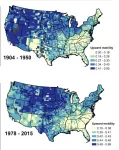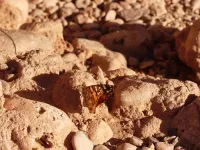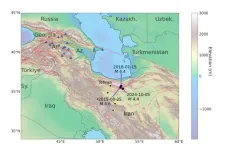(Press-News.org) New assessment warns area the size of the USA will become too hot during extreme heat events for even healthy young humans to maintain a safe body temperature if we hit 2°C above preindustrial levels.
For those aged over 60, the same 2°C rise would see more than a third of the planet’s land mass cross this critical ‘overheating’ threshold
An international group of scientists, led by King’s College London, has revealed how continued global warming will lead to more parts of the planet becoming too hot for the human body over the coming decades.
The paper, published in Nature Reviews Earth and Environment, finds that the amount of landmass on our planet that would be too hot for even healthy young humans (18-60-year-olds) to keep a safe core body temperature will approximately triple (to six percent) – an area almost the size of the US – if global warming reaches 2°C above the preindustrial average.
Under these conditions, they also warn that the area of land where the over 60s will be at risk will increase to about 35%.
Last year was the first calendar year with a global mean temperature of more than 1.5°C above the pre-industrial average, and at current rates of warming, 2°C could be reached by mid to late century.
Dr Tom Matthews, lead author and Senior Lecturer in Environmental Geography at King’s College London said: “Our findings show the potentially deadly consequences if global warming reaches 2°C. Unsurvivable heat thresholds, which so far have only been exceeded briefly for older adults in the hottest regions on Earth, are likely to emerge even for younger adults. In such conditions, prolonged outdoor exposure – even for those if in the shade, subject to a strong breeze, and well hydrated – would be expected to cause lethal heatstroke. It represents a step-change in heat-mortality risk ”.
For their assessment, the team drew together scientific findings to link physical climate science with heat mortality risk, including crossing ‘uncompensable’ and ‘unsurvivable’ thresholds. Scientists distinguish between uncompensable thresholds, beyond which human core body temperature rises uncontrollably, and unsurvivable thresholds, where the body’s core temperature increases to 42°C within six hours.
Between 1994-2023, human thermal tolerances, the combination of temperature and humidity, above which the human body can’t cope - were breached for about 2% of the global land area for adults under 60. More than 20% of the Earth’s land surface crossed this threshold for older adults, who are more vulnerable to heat stress.
Whilst uncompensable thresholds have been passed for all ages, unsurvivable thresholds have so far only been passed briefly for older adults.
For higher warming levels of 4-5°C above preindustrial, older adults could experience uncompensable heat across around 60% of the Earth’s surface during extreme events. At this level of warming, unsurvivable heat would also begin to emerge as a threat to younger adults in the hottest subtropical regions.
Certain regions are more at risk of crossing the critical uncompensable and unsurvivable thresholds, with people in Saharan Africa and South Asia most in the firing line.
Dr Matthews said anticipating the magnitude of future heat extremes and their worst-case impacts is critical to understanding the costs of failing to mitigate climate change. It is also crucial for targeting adaptation efforts at those communities most in need.
“What our review really shows very clearly is that, particularly for higher levels of warming such as 4°C above the pre-industrial average, the health impacts of extreme heat could be extremely bad,” he said.
“At around 4°C of warming above preindustrial levels, uncompensable heat for adults would affect about 40% of the global land area, with only the high latitudes, and the cooler regions of the mid-latitudes, remaining unaffected.
“Interdisciplinary work is vital to improving our understanding of unprecedented heat’s deadly potential and how it can be reduced. As more of the planet experiences outdoor conditions too hot for our physiology, it will be essential that people have reliable access to cooler environments to shelter from the heat”.
Since 2000 there have been more than 260,000 heat related fatalities in the deadliest heat events, showing how extreme heat is already a huge threat to human life.
The three deadliest heat events of the 21st Century collectively caused nearly 200,000 deaths, including about 72,000 across Europe during 2003, another 62,000 across Europe in 2022, and the Russian heatwave of 2010, which killed around 56,000.
The study also involved Dr Josh Foster from King’s College London, and researchers from the University of California, Stanford University, the NASA Goddard Institute for Space Studies, Columbia University and Boston University.
END
Half a degree rise in global warming will triple area of Earth too hot for humans
2025-02-04
ELSE PRESS RELEASES FROM THIS DATE:
Identifying ED patients likely to have health-related social needs
2025-02-04
INDIANAPOLIS -- Addressing patients’ health-related social needs such as housing instability, food insecurity, transportation barriers and financial strain is important to improving health outcomes yet can be challenging. A new study from Regenstrief Institute and Indiana University Indianapolis Richard M. Fairbanks School of Public Health investigates the best approach to predicting likely need for one or more health-related social need services.
To identify emergency department (E.D.) patients needing these services, researchers ...
Yo-yo dieting may significantly increase kidney disease risk in people with type 1 diabetes
2025-02-04
WASHINGTON—Body-weight cycling (also known as yo-yo dieting) has been shown to significantly increase the risk of kidney disease in people with type 1 diabetes, regardless of body mass index (BMI) and other traditional risk factors, according to a new study published in the Endocrine Society’s Journal of Clinical Endocrinology & Metabolism.
Yo-yo dieting is defined as repeatedly losing and gaining weight multiple times over the years. Its prevalence is reported to be as high as 35% in men and 55% in women.
This patten of dieting has been shown to increase risks of cardiovascular events ...
Big cities fuel inequality
2025-02-04
A study combining remote sensing and administrative data finds that since the mid-20th century, large, growing cities have ceased to be centers of upward social and economic mobility.
Cities have been celebrated as places of innovation and social mobility but also as hotspots of inequality and poverty. Dylan Shane Connor and colleagues measured how the size, density, and connectedness of urban areas in an American’s birth county predicted their social mobility across the 20th century. The results tell a tale of a waning relationship between ...
Financial comfort and prosociality
2025-02-04
People who feel financially comfortable are more likely to report prosocial actions like donating money and prosocial attitudes than people in a tough financial situation, according to a study. Prosociality—preferences and behaviors that benefit others—is essential to human society. In practice, it is determined by both the desire and the ability to help. Paul Vanags and colleagues analyzed data from the Global Preferences Survey and the Gallup World Poll, including 80,337 people in 76 countries with incomes ranging from about $200 a year to about $380,000 per year, adjusted to be equivalent across the different countries ...
Painted lady butterflies migrations and genetics
2025-02-04
A broadly distributed migratory butterfly travels varying distances, influenced by environmental conditions rather than following genetically coded instructions, according to a study. The Afro-Palearctic population of the painted lady butterfly, Vanessa cardui, is a single freely interbreeding, or ‘panmictic’ population.
Vanessa cardui is a renowned world traveler, undertaking multigenerational migrations throughout Africa, Asia, Europe, and North America. The winter breeding range of painted ladies in the Afro-Palearctic includes areas north and south of the Sahara ...
Globetrotting not in the genes
2025-02-04
Painted lady butterflies are world travelers. The ones we encounter in Europe fly from Africa to Sweden, ultimately returning to areas north and south of the Sahara. But what determines whether some butterflies travel long distances while others travel short distances? A group of scientists, including from the Institute of Science and Technology Austria (ISTA), shows that the different migration strategies are shaped by environmental conditions rather than being encoded in the butterfly’s DNA.
It is a warm summer day in June. A group of scientists with sunhats and nets is hiking along a trail in the Catalan mountains. They meticulously search for painted ladies—vibrant orange ...
Patient advocates from NCCN guidelines panels share their ‘united by unique’ stories for world cancer day
2025-02-04
PLYMOUTH MEETING, PA [February 4, 2025] — The National Comprehensive Cancer Network® (NCCN®) is joining people and organizations across the globe to commemorate World Cancer Day today. World Cancer Day is a global initiative to improve awareness and knowledge of cancer risks and actions for better prevention, detection, and treatment. It is led and organized by the Union of International Cancer Control (UICC) every February 4.
World Cancer Day 2025 marks the start of the ‘United by Unique’ campaign to highlight how every experience with cancer is unique, even as people touched by cancer ...
Innovative apatite nanoparticles for advancing the biocompatibility of implanted biodevices
2025-02-04
Medical implants have transformed healthcare, offering innovative solutions with advanced materials and technologies. However, many biomedical devices face challenges like insufficient cell adhesion, leading to inflammatory responses after their implantation in the body. Apatite coatings, particularly hydroxyapatite (HA)—a naturally occurring form of apatite found in bones, have been shown to promote better integration with surrounding tissues. However, the biocompatibility of artificially synthesized apatite nanoparticles often falls short of expectations, primarily due to the nanoparticles’ limited ability to bind effectively with biological tissues.
To overcome ...
Study debunks nuclear test misinformation following 2024 Iran earthquake
2025-02-04
A new study debunks claims that a magnitude 4.5 earthquake in Iran was a covert nuclear weapons test, as widely alleged on social media and some mainstream news outlets in October 2024, a period of heightened geopolitical tensions in the Middle East.
Led by Johns Hopkins University scientists, the study warns about the potential consequences of mishandling and misinterpreting scientific information, particularly during periods of international conflict. The findings appear in the journal Seismica.
“There was a concerted misinformation and disinformation campaign around this event that promoted the idea this was a nuclear test, ...
Quantum machine offers peek into “dance” of cosmic bubbles
2025-02-04
Physicists have performed a groundbreaking simulation they say sheds new light on an elusive phenomenon that could determine the ultimate fate of the Universe.
Pioneering research in quantum field theory around 50 years ago proposed that the universe may be trapped in a false vacuum – meaning it appears stable but in fact could be on the verge of transitioning to an even more stable, true vacuum state. While this process could trigger a catastrophic change in the Universe's structure, experts agree that predicting the timeline ...






